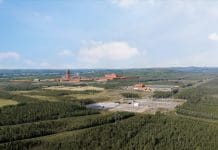Wind effects are a key consideration in the design of tall buildings – but a new study suggests that the difficulty in estimating damping has led to an overly cautious approach. Lead author Daniel Gonzalez-Fernandez of the University of Bristol discusses the work to develop a more accurate model that could unlock faster construction
Wind effects are a primary concern in the design of tall buildings. Although strong wind gusts can cause oscillation in the structures, these vibrations do not usually lead to structural safety issues because of their generally low amplitudes.
However, occupant comfort is directly related to wind-induced sway, which can interfere with the users’ daily activities and general wellbeing. Prolonged exposure can cause low-dose motion sickness, with symptoms including tiredness and feeling “off” that results in occupant discomfort.
Thus, it is paramount to mitigate the impact of wind actions in tall buildings in order to meet the performance criterion for serviceability regarding human comfort, enhance their structural performances and increase their lifespan.
Moreover, understanding the wind-induced structural response has become more critical in recent years since there is a trend for tall buildings to become more slender and hence more sensitive to wind-induced vibrations.
Addressing problems in estimating damping accurately
Since the response of a structure subjected to dynamic loading (eg wind) is strongly affected by its damping, its estimation is paramount. Unfortunately, there are several difficulties in estimating damping accurately in large civil engineering structures, from operational modal analysis.
The lack of universally accepted principles to predict the damping factors in complex systems has usually led to the use of predominantly empirical models, which cannot be generalised accurately to all types of buildings and cannot accurately describe the physical process behind them.
Given the complexity of this type of structural system, these predictive models, which have been used for convenience in design, require update and validation through in-situ measurements of the modal characteristics, such as modal damping and natural frequencies.
Therefore, our research intends to address this drawback by studying the damping characteristics of a tall building, obtained from the full-scale wind-induced responses using a minimal monitoring system. The aim is to elucidate the nature and the origin of some trends in the modal parameters observed in this specific context under varying wind conditions.
This work uses full-scale vibration measurements acquired between October 2017 and October 2018 on a 47-floor, 150m-high building in London using three accelerometers and an anemometer installed on the top height of the tower.
This analysis has sought to strengthen and complement the limited existing literature on the long-term variation of the modal parameters of this type of building in relation to environmental conditions or changes in the system physical parameters.
The identified modal parameters, damping ratios and natural frequencies have been evaluated in relation to a series of factors, including time, amplitude, wind speed and wind direction.
The most influential parameter that governs the wind-induced damping and frequency responses has been observed to be amplitude. The acceleration amplitudes for the different modes were obtained from the power spectral densities of the acceleration by integrating them over the frequency range of interest of the relevant resonant peak or consecutive peaks.
A gradual increase in the damping ratio values has been found for increasing acceleration amplitudes and wind speed, which are linked to wind loading. Thus, the dissipation of energy and consequently mitigation of the oscillations associated with this increase has a positive effect on the integrity of the structure.
Aiming to identify the main source of damping, a novel analysis has used the apparent aerodynamic damping gradient as the main feature to support the assumption that aerodynamic damping was responsible for the experimental variations considering the different combinations of wind directions.
However, the similarity of trends for the damping-wind speed relationships with respect to different wind orientations has led to the conclusion that the aerodynamic effects on the aeroelastic behaviour of the building are dominated by the amplitude-dependent structural effects on the damping.
Finally, a new empirical damping prediction model has been proposed to better represent the amplitude-dependent behaviour of the damping measures obtained from the full-scale measurements compared with six existing models in literature.
In this analysis, the displacement amplitude obtained by double integration of the acceleration PSDs has been estimated for comparison with the previously selected models. The data were approximated by an updated regression model combining the power law and the damping ratio constant corresponding to the near-zero response amplitude, although there is still an open discussion within the community on the definition of the function at high amplitudes.
Using the proposed damping model, the amplitude-dependent damping ratio values were shown to range from 0.6% for the near-zero amplitudes to 2.1% for the high amplitude conditions.
The full study can be accessed via the link below: Identification of varying modal parameters of a tall building from the full-scale wind-induced responses – ScienceDirect.
Daniel Gonzalez-Fernandez
PhD researcher
University of Bristol, Department of Civil Engineering
Tel: +44 (0)757 023 9095
d.gonzalez-fernandez@bristol.ac.uk

















